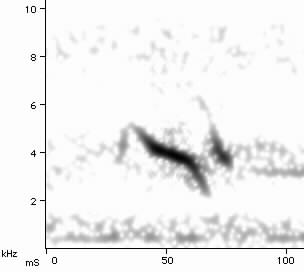
Red Crossbill Loxia curvirostra
Flight call descriptions Variable, with different populations giving distinctly different flight calls. The categories or "types" presented here are based on Groth (1993). See Subspecies below. All types deliver alternating sets of one to four short, relatively pure-toned notes in a rapid cadence of three to four notes per second.
Type 1: A short, descending "chewt".
Type 2: A low, pure-toned, descending "cheewp".
Type 3: A harsh, squeaky, descending "chyet".
Type 4: A pure-toned, distinctly rising "pwit". Within this group, there may be two categories with birds in the Mid-Atlantic region giving calls that are shorter, higher, and more steeply rising than birds in Minnesota.
Type 8: A low, slightly rising "pwet".
Fig.1. Tennessee June 20, 2001 (WRE).
Type 1 call from bird in flight.
Fig.2. Ontario November 29, 2000 (WRE).
Type 2 call from bird in flight.
Fig.3. New Jersey January 1, 1998 (MO).
Type 3 call from bird in flight.
Fig.4. Minnesota November 26, 2000 (WRE).
Type 4 call from bird in flight.
Examples Diurnal
Similar species See White-winged Crossbill. Redpoll "tchet" calls are more vibrant and complex than the relatively pure-toned flight calls of Red Crossbill. House Finch flight calls are softer and more vibrant than Red Crossbill's.
Subspecies Groth (1993) has shown that there are nine spectrographically distinct vocal groups or "types" of Red Crossbills, possibly representing cryptic species, occurring in North America. This "type" system of classification does not correspond neatly with previous subspecies taxonomy (see Pyle 1997 for more detail on subspecies). Of the nine Red Crossbill types, types 2, 3, and 4 are known to occur widely in northeastern North America. Type 1 is found in the southern Appalachians. Type 8 is known only from Newfoundland and is thought to be extremely rare. Some types, particularly types 2, 3, and 4, are known to be irruptive migrants. Within each specific type there is variation, some of which may represent unique populations (note especially the variation within type 4). We present a relatively simple overview of the complex here. For more detailed information, see Groth (1993).
Differences between flight calls of the different Red Crossbill types are recognizable with practice. Type 4 is the most distinctive, being the only one that is distinctly rising. Type 8 is apparently most similar to type 4 but is lower and less distinctly rising (Groth, 1993). Type 2 is lower-pitched, longer, and softer than other types and is clearly descending. Type 1 is higher-pitched, shorter, and harder than type 2. Type 3 is descending like types 1 and 2 but is higher, harsher, and squeakier.
Behavior Thought to be primarily diurnal migrants but begins movements well before sunrise. Gives flight calls regularly while perched and in flight during the day. Not known to give flight calls at night.